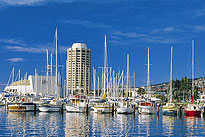Tasmania
Tasmania, Australia’s island state, has a lot to offer with 17 national parks, charming regional towns and historical convict sites.
It has a distinctive history and wildlife that can be found nowhere else, making it unique both geographically and culturally.
key facts

- Location: A triangle-shaped island off Australia’s south-east corner
- Population: 515,000
- Size: 68,401 km2
weather
The weather in Tasmania is mild and temperate, though winters can be very chilly.
- Summer average: 12–18°C
- Winter average: 3–12°C
- Average rainfall: 600–3,000 mm
local economy
Mining is an important part of the Tasmanian economy, with the production of metals bringing more than AUD $1.3 billion into the state each year.
Other key contributors to the Tasmanian economy include wood and paper, meat, dairy, seafood, manufactured goods and tourism.
The cost of living in Tasmania is relatively low for an Australian state, and Hobart has more affordable housing than any other state capital in the country.
about tasmania

Tasmania’s abundance of stunning landscapes make it a popular hiking destination.
Around one fifth of the state’s land is classified as The Tasmanian Wilderness World Heritage Areas, known to be one of the last true wilderness regions on Earth.
Tasmania is also home to a number of notable cultural venues including Australia’s second oldest museum, the Tasmanian Museum and Art Gallery on Hobart’s waterfront, and MONA (the Museum of Old and New Art), which hosts an impressive range of festivals and contemporary art.
Interestingly, the Indigenous population of Tasmania lived in total isolation from the rest of humanity for 10,000 years after rising sea levels cut Tasmania off from mainland Australia.
about hobart
 Australia’s second oldest state capital, Hobart, sits at the foot of Mount Wellington and has a wealth of heritage charm.
Australia’s second oldest state capital, Hobart, sits at the foot of Mount Wellington and has a wealth of heritage charm.
This is certainly true for Salamanca place, which is just a short walk from Hobart’s waterfront and has an array of galleries, restaurants and shops housed in Georgian warehouses dating back to the 1830s.
On Saturdays the area comes alive as Salamanca market opens and offers gourmet produce, crafts and handiwork from across Tasmania.
Tassie’s proximity to the Southern Ocean gives it a rich maritime culture, from fresh seafood to Antarctic supply vessels at The Port.


